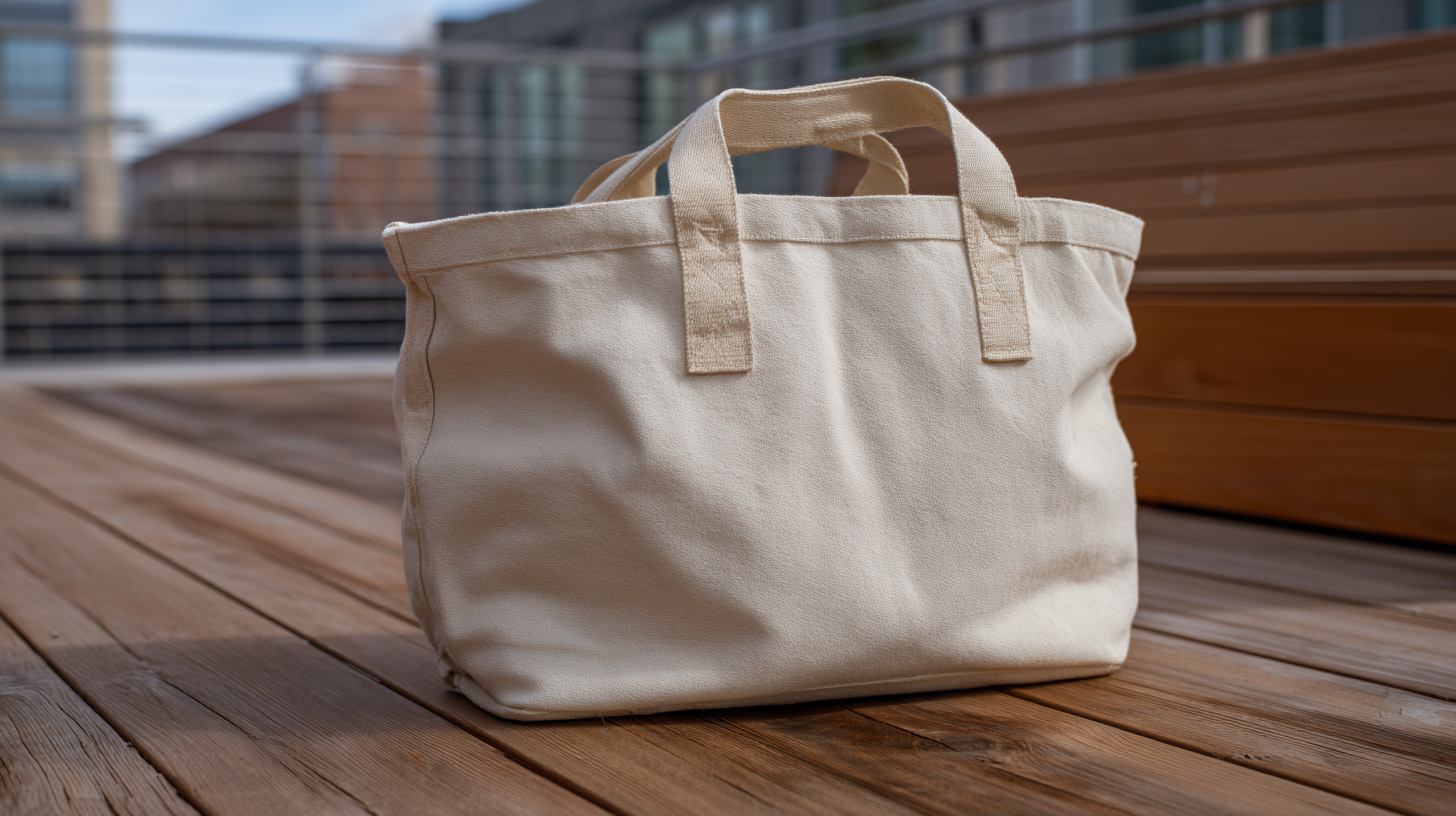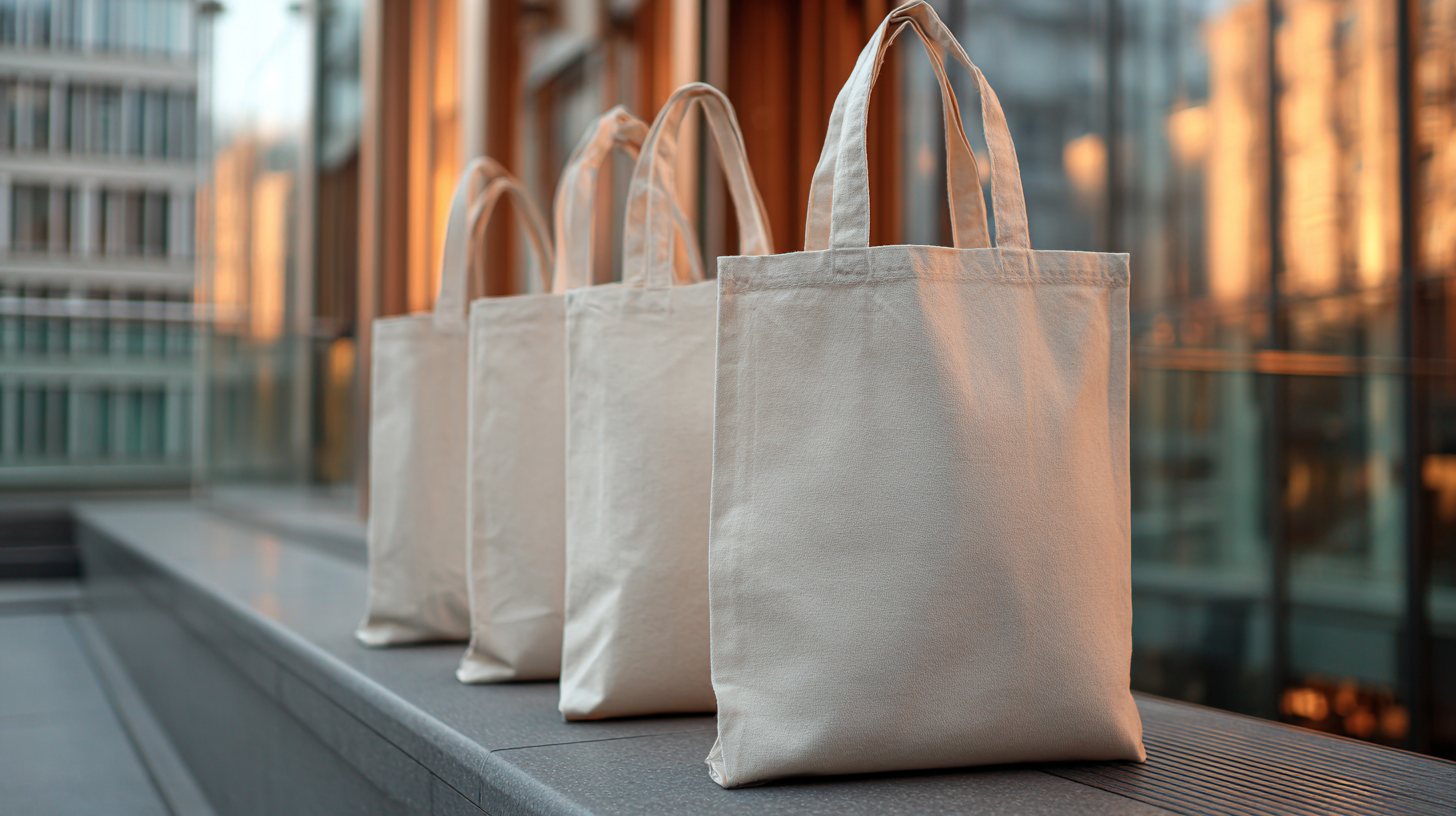
Navigating 2025 Technology Trends in Sustainable Cotton Canvas Tote Bags for Global Buyers
As we approach 2025, the global market for sustainable fashion continues to expand, reflecting a growing consumer awareness and demand for eco-friendly products. According to a report by ResearchAndMarkets, the sustainable fashion market is projected to reach USD 8.25 billion by 2023, with an increasing shift towards materials that minimize ecological impact. One standout in this category is the Cotton Canvas Tote Bag, celebrated for its durability and versatility.

The global cotton bag market is surging, with experts noting a projected annual growth rate of 25% through the next several years. This trend not only signifies a commitment to sustainability but also aligns with evolving consumer preferences prioritizing both style and substance. In this blog, we will delve into the 2025 technology trends influencing the production and design of Cotton Canvas Tote Bags, providing global buyers with insights on how to navigate this dynamic market effectively.
Key Innovations in Sustainable Cotton Canvas Tote Bags by 2025
As we approach 2025, the sustainable fashion industry continues to innovate, particularly in the realm of cotton canvas tote bags. Recent reports indicate that the demand for eco-friendly products is skyrocketing, with a projected market growth rate of 10.3% annually for sustainable bags globally (Statista, 2023). This trend is largely influenced by consumers who are becoming increasingly aware of their environmental footprint, pushing manufacturers to explore sustainable practices from sourcing to production.
One of the key innovations in sustainable cotton canvas tote bags is the integration of recycled materials. According to a 2022 Research and Markets report, brands are now experimenting with recycled cotton and other fibers, significantly reducing water usage and chemical emissions associated with traditional farming and production methods. Additionally, advancements in digital printing technology allow for more intricate designs without the waste that typically accompanies conventional printing processes. As brands adopt these innovations, they not only meet consumer demand but also contribute to a circular economy, which is essential for the environment.
Moreover, supply chain transparency is becoming a hallmark of leading companies in this sector. A survey by the Global Fashion Agenda revealed that 75% of consumers prefer brands that provide detailed information about the materials used in their products. This trend is encouraging brands to disclose their sourcing practices and implement more sustainable supply chains, which will be critical in maintaining consumer trust and loyalty by 2025. This combination of technological advancements and consumer demand continues to shape the landscape of sustainable cotton canvas tote bags, paving the way for a more eco-conscious future.
Navigating 2025 Technology Trends in Sustainable Cotton Canvas Tote Bags for Global Buyers - Key Innovations in Sustainable Cotton Canvas Tote Bags by 2025
| Innovation | Description | Expected Impact | Implementation Year |
|---|---|---|---|
| Biodegradable Coatings | Use of natural, biodegradable materials for added durability without compromising sustainability. | Reduced environmental footprint and enhanced product life cycle. | 2025 |
| Recycled Cotton Blend | Integrating recycled cotton fibers into canvas production to minimize waste. | Lower resource consumption and contribute to a circular economy. | 2025 |
| Water-Saving Technology | Innovative dyeing and finishing techniques that reduce water usage significantly compared to traditional methods. | Conservation of water resources and improved operational efficiency. | 2024 |
| Digital Printing Technology | Utilizing digital printing techniques to minimize ink waste and facilitate customization. | Enhanced design possibilities and reduced waste generation. | 2025 |
| Smart Fabric Integration | Incorporating technology into fabrics, such as embedded sensors for tracking and sustainability monitoring. | Improved consumer engagement and more effective supply chain management. | 2025 |
Evaluating Eco-Friendly Materials: Comparing Cotton to Alternatives
As global consumers become increasingly eco-aware, the materials used in sustainable cotton canvas tote bags are under scrutiny. The comparative analysis of cotton against alternatives like recycled polyester and sisal fibers reveals a complex landscape. While cotton is a traditional choice known for its breathability and durability, new studies highlight the potential of sisal as a cost-effective and environmentally friendly replacement. Sisal fibers, being locally sourced, provide a sustainable solution for industries like absorbent hygiene and textiles, particularly in regions like Morocco.
However, the dilemma of choosing between sustainable cotton and recycled polyester remains prevalent. This choice is not just about material but also encompasses the entire lifecycle of the product. Eco-conscious brands are now emphasizing transparency in their supply chains, helping consumers make informed decisions based on sustainability metrics.
Additionally, innovations in bio-based softeners and flame retardants are enhancing the functionality of natural fibers, ensuring that they meet modern safety standards while maintaining their eco-friendly stance. As the fashion industry shifts towards circularity, the design and manufacturing processes must adapt to become more recyclable and less wasteful, paving the way for a greener future in textile production.
The Role of Technology in Enhancing Bag Production Sustainability
The pursuit of sustainability in the production of cotton canvas tote bags is increasingly intertwined with advancements in technology. Modern techniques are enabling manufacturers to enhance the sustainability of their operations, minimizing waste and reducing environmental impact. Innovations like artificial intelligence and the Internet of Things (IoT) are becoming crucial in optimizing production processes, ensuring better resource management, and enhancing the longevity of the bags produced.
Tip: To improve the sustainability of tote bags, consumers should look for brands that incorporate recycled materials and utilize eco-friendly production methods. Understanding the lifecycle of a product and supporting companies committed to circular economy principles can significantly influence demand for sustainable products.
Recent achievements in recycling and circular economy technologies are vital for sustainable production. The transformation of post-consumer materials into new products not only reduces waste but also drives down the need for virgin resources. Techniques adopted from lean manufacturing principles are promoting efficiency in bag production as companies become more data-driven in their decision-making processes.
Tip: Consider the environmental footprint of your tote bag purchase by analyzing the supply chain transparency provided by brands. Brands that share their sustainability practices and material sourcing can help consumers make informed choices that support sustainable development in the textile industry.

Consumer Preferences Shaping the Future of Tote Bag Designs
As global consumers become increasingly aware of sustainability issues, their preferences are significantly influencing the design and production of cotton canvas tote bags. A recent report by the Global Sustainable Textile Coalition indicates that 70% of consumers prioritize eco-friendly materials when purchasing bags. This shift in consumer behavior is prompting brands to select organic cotton and implement ethical sourcing practices, resulting in a rising demand for sustainable tote bags in retail spaces.
When developing new tote bag designs, companies should consider incorporating unique features that reflect consumer preferences, such as versatility and functionality. According to a study by Market Research Future, the demand for multi-purpose tote bags has surged by 40% in the past three years. Brands that embrace innovative designs—like detachable straps or integrated storage compartments—will likely capture the interest of eco-conscious consumers.
Tips for brands aiming to align with these trends include conducting consumer surveys to identify desired features and leveraging social media to engage with customers about sustainable practices. Furthermore, collaborating with local artisans can enhance the uniqueness of each tote bag while promoting community sustainability. By staying attuned to consumer preferences, businesses can effectively navigate the evolving landscape of sustainable fashion.
Navigating 2025 Technology Trends in Sustainable Cotton Canvas Tote Bags
Case Studies: Successful Brands Leading the Sustainable Tote Market
Sustainable fashion continues to gain momentum, especially in the luxury market, projected to grow from $28.4 billion in 2023 to $39.24 billion by 2030, reflecting a compound annual growth rate of 4.7%. As global buyers seek eco-friendly options, sustainable cotton canvas tote bags are emerging as a preferred choice. Successful brands are not just selling a product; they're promoting a lifestyle that resonates with environmentally conscious consumers. Using case studies from leading brands, we can see how integrating sustainability into their core strategy has helped them capture market share while also addressing consumer concerns about environmental impact.

Tip 1: Brands aiming to enter the sustainable canvas tote market should prioritize transparency in their supply chains. By openly communicating about sourcing materials and production processes, companies can build trust and loyalty among consumers who value ethical practices.
Tip 2: Understanding regional consumer insights is critical. For example, recent studies indicate that Chinese consumers are increasingly influenced by sustainability narratives, which present both opportunities and challenges for brands looking to penetrate these markets. Adapting marketing strategies to highlight eco-friendly practices can significantly boost brand appeal in these demographics.
By learning from successful examples, brands can navigate the complex landscape of sustainable products, ensuring they not only meet market demands but also contribute positively to global environmental efforts.



